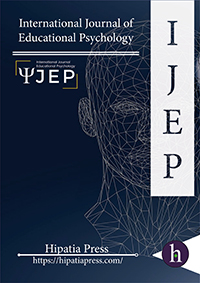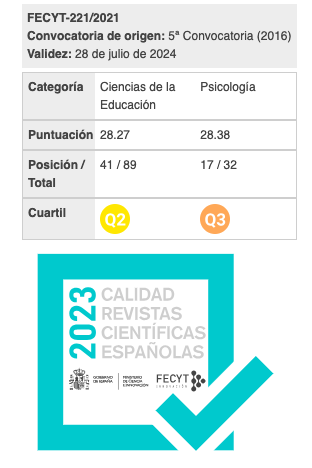The importance of socio-affective relationships in educational contexts
Validation of a closeness-conflict scale and a motivational communication scale
Keywords:
Downloads
Abstract
In studies on the motivational classroom climate -CMC- the need to delve into socio-affective aspects that make up the pedagogical relationships -PR- between teachers and students that affect the closeness and communication is recognized. That is why this work seeks to validate the design of two evaluation instruments focused on PR (Closeness/Conflict Scale and Motivational Communicational Scale) applied to 459 students from technical secondary schools (Argentina) and establish links with the CMC as well as with the satisfaction and interest achieved in terms of the relevance of school learning. The results found prove that the two assessment scales created meet measurement guarantees, showing encouraging reliability, internal, convergent and predictive validity data. Likewise, the relationships between the Motivational Communication and Closeness scales are strong since significant correlations were found. The relationship model between communication/closeness/conflict turned out to explain the satisfaction that students perceive of their teachers, demonstrating the importance of the main determinants of PR (closeness, communication and conflict) for the CMC and contributing to the evaluation of educational interventions focused on improving the climate.
Downloads
References
Abello, D. M., Alonso-Tapia, J., & Panadero, E. (2021). Classroom motivational climate in a Higher Education context: Validation of a model for evaluation and intervention. International Journal of Instruction, 14(2), 685-702. https://doi.org/10.29333/iji.2021.14238a
Google Scholar CrossrefAERA, APA & NCME. (2014). Standards for educational and psychological testing. Washington DC: American Psychological Association.
Google Scholar CrossrefAlonso Tapia, J. (2017). School climate and classroom climate: review of successful school climate programmes and policies, and rationale for the selection of measurement instruments. Technical report 1. Costa Rica: Ministry of Public Education/Inter-American Development Bank.
Google Scholar CrossrefAlonso Tapia, J. (2012). Psychopedagogical evaluation and educational orientation: Concept, coordinates, process and approaches. J. Alonso-Tapia, Psychopedagogical evaluation and educational orientation, 1, (pp. 21-62). Synthesis.
Google Scholar CrossrefAlonso Tapia, J., & Fernández, B. (2008). Development and initial validation of the classroom motivational climate questionnaire (CMCQ). Psicothema, 20(4), 883-889.
Google Scholar CrossrefAlonso Tapia J., & Fernández, B. (2009). Motivational classroom climate: cross-cultural validity and educational implications. Childhood and Learning, 32, 597-612. https://doi.org/10.1387/RevPsicodidact.13034
Google Scholar CrossrefAlonso Tapia, J. & Nieto, C. (2019). Classroom Emotional Climate: Nature, Measurement, Effects and Implications for Education. Revista de Psicodidáctica, 24(2), 79-87. https://doi.org/10.1016/j.psicoe.2018.09.002
Google Scholar CrossrefAlonso Tapia, J., & Ruiz, M. A. (2007). Motives related to learning and perceptions of environment motivational quality: How do they interact in university students? Psicothema, 19(4), 602-608.
Google Scholar CrossrefAlonso Tapia, J., Ruiz, M.A., & Huertas, J. A. (2020). Differences in the motivational climate in the classroom: causes, effects and implications for teacher training. A multilevel study. Annals of Psychology, 36(1), 122-133. https://doi.org/10.6018/analesps.337911
Google Scholar CrossrefAmes, C. (1992). “Achievement goals and the classroom motivational climate”. In D. H. Schunk & J. L. Meece (eds.). Students perceptions in the classroom (pp. 327-348). Lawrence Erlbaum Associates, Inc.
Google Scholar CrossrefBardelli, N. (2017). Emotional classroom climate: Design of an intervention program on closeness relationships in the secondary school classroom as a pedagogical counseling strategy. Master's Thesis. FLACSO-UAM
Google Scholar CrossrefBriñol, P., Petty, R. E., Durso, R. O., & Rucker, D. D. (2017). Power and persuasion: Processes by which perceived power can influence evaluative judgments. Review of General Psychology, 21, 223-241. https://doi.org/10.1037/gpr0000119
Google Scholar CrossrefBrown, G., Harris, L., O'Quin, C., & Lane, K. (2015). Using multi-group confirmatory factor analysis to evaluate cross-cultural research: identifying and understanding non-invariance. International Journal of Research & Method in Education, 40(1), 1-25. https://doi.org/10.1080/1743727X.2015.1070823
Google Scholar CrossrefElliot, A. J., & Thrash, T. M. (2001). Achievement goals and the hierarchical model of achievement motivation. Educational Psychology Review, 13, 139-156. https://doi.org/10.1023/A:1009057102306
Google Scholar CrossrefEpstein, J. L. (1989). “Family structures and student motivation: A developmental perspective. In C. Ames and R. Ames (eds.), Research on motivation in education (pp. 259-295). Academic Press.
Google Scholar CrossrefErtürk Kara, G.; Gönen, M., & Pianta, R. (2017). The Examination of the Relationship between the Quality of Teacher-Child Interaction and Children’s Self-Regulation Skills. Journal of Education. Hacettepe Üniversitesi Eğitim Fakültesi Dergisi, 32(4), 880-895.
Google Scholar Crossrefhttp://doi10.16986/HUJE.2016018694
Google Scholar CrossrefEvans, I.M., Harvey, S.T., Buckley, L., & Yan, E. (2009). Differentiating classroom climate concepts: academic, management, and emotional environments. New Zealand Journal of Social Sciences Online, 4, 131-146. https://doi.org/10.1080/1177083X.2009.9522449
Google Scholar CrossrefFerres, J., & Masanet, M.J. (2017). Communicative effectiveness in education: enhancing emotions and storytelling. Comunicar, 52(25), 51-60. http://doi.org/10.3916/C52-2017-05
Google Scholar CrossrefFraile, J., Pardo, R., & Panadero, E. (2017). How to use rubrics to implement a true formative evaluation? Complutense Journal of Education, 28(4), 1321-1334. https://doi.org/10.5209/RCED.51915
Google Scholar CrossrefGinsberg, S. (2007). Teacher transparency: What students can see from Faculty communication. Journal of Cognitive Affective Learning, 4(1).
Google Scholar CrossrefHair, J. F. (2014). A primer on partial least squares structural equations modeling (PLS-SEM). Sage.
Google Scholar CrossrefHuertas, J. A. (2012). The effects of affects on motivation and self-regulation. Psychological Sciences, 6(1), 45-55. https://doi.org/10.22235/cp.v6i1.62
Google Scholar CrossrefHuertas, J., & Montero, I. (2001). Classroom Interaction. Aique.
Google Scholar CrossrefHuertas, J., Bardelli, N. E., & Martín García, L. (2020). Collaborative pedagogical counseling in secondary school: action-research experience based on intervention in the motivational and emotional classroom climate. IICE Journal, 46, 113-132. https://doi.org/10.34096/iice.n46.8592
Google Scholar CrossrefJoe, H.-K., Hiver, P., & Al-Hoorie, A. H. (2017). Classroom social climate, self-determined motivation, willingness to communicate, and achievement: A study of structural relationships in instructed second language settings. Learning and Individual Differences, 53, 133-144. https://doi.org/10.1016/j.lindif.2016.11.005
Google Scholar CrossrefJorgensen, T. D., Pornprasertmanit, S., Schoemann, A. M., & Rosseel, Y. (2022). SemTools: Useful tools for structural equation modeling. R package version 0.5-6.
Google Scholar CrossrefKaplan, A.; Gheen, M., & Midgley, C. (2010). Classroom goal structure and student disruptive behaviour. British Journal of Educational Psychology, 72, 191-211. https://doi.org/10.1348/000709902158847
Google Scholar CrossrefKorkmaz, S., Goksuluk, D., & Zararsiz, G. (2014). MVN: An R Package for Assessing Multivariate Normality”. The R Journal, 6(2), 151-162. https://doi.org/10.32614/RJ-2014-031
Google Scholar CrossrefLazonder, A. W., & Harmsen, R. (2016). Meta-Analysis of Inquiry-Based Learning: Effects of Guidance. Review of Educational Research, 86(3), 643-680. https://doi.org/10.3102/0034654315627366
Google Scholar CrossrefLazowski, R. A., & Hulleman, C.S. (2016). Motivation Interventions in Education: A Meta-Analytic Review. Review of Educational Research, 86(2), 602-640. https://doi.org/10.3102/0034654315617832
Google Scholar CrossrefLiu, W., Mei, J., Tian, L., & Huebner, E. S. (2016). Age and gender differences in the relation between school-related social support and subjective well-being in school among students. Social Indicators Research, 125, 1065-1083. http://doi.org/10.1007/s11205-015-0873-1
Google Scholar CrossrefLloret-Segura, S., Ferreres-Traver, A., Hernández-Baeza, A., & Tomás-Marco, I. (2014) The exploratory factor analysis of the items: a practical guide, revised and updated. Annals of psychology, 30(3), 1151-1169. http://doi.org/10.6018/analesps.30.3.199361
Google Scholar CrossrefMartinez, A., McMahon, D., Espelage, D., Anderman, M., Reddy, L.A., & Sanchez, B. (2016). Teachers’ experiences with multiple victimization: identifying demographic, cognitive, and contextual correlates. Journal of School Violence, 15(4), 387-405. http://doi.org/10.1080/15388220.2015.1056879
Google Scholar CrossrefMcMahon, S.D., Martinez, A., Reddy, L.A., Espelage, D.L., & Anderman, E.M. (2017). Predicting and reducing aggression and violence toward teachers: Extent of the problem and why it matters. In P. Sturmey (ed.), The Wiley handbook of violence and aggression (pp. 1-13). John Wiley & Sons.
Google Scholar CrossrefMehrabian, A. (1981). Silent messages: Implicit communication of emotions and attitudes (2nd ed.). Belmont
Google Scholar CrossrefMeyer, D.K., & Turner, J.C. (2002) Discovering Emotion in Classroom Motivation Research. Educational Psychologist, 32(2), 107-114. https://doi.org/10.1207/S15326985EP3702_5
Google Scholar CrossrefMidgley, C., Maehr, M.L., Hruda, L., Anderman, E., Anderman, L., Freeman, K.E., & Urdan, T. (2000). Manual for the Patterns of Adaptive Learning Scales. Ann Arbor, MI: University of Michigan.
Google Scholar CrossrefMoreno García, R. & Martínez-Arias, R. (2008). Spanish adaptation of the teacher-student relationship scale (STRS). Educational psychology, 14(1), 11-27.
Google Scholar CrossrefPekrun, R., & Linnenbink-Garcia, L. (2012). “Academic emotions and student engagement”. In S. Christenson, A. Reschly, & C. Wylie (Eds.), Handbook of research on student engagement (pp. 259-82). Springer International Publishing.
Google Scholar CrossrefPasek, J., & Tahk, A. (2021). R-core: Additional contributions by Gene Culter and Marcus Schwemmle. In J. Pasek Weights: Weighting and Weighted Statistics (pp. 6-21). CRAN.
Google Scholar CrossrefPianta, R. C. (2001). STRS. Student-Teacher Relationships Scale. PAR. Psychological Assessment Resources, Inc.
Google Scholar CrossrefPianta, R. C., & Allen, J. P. (2008). Building capacity for positive youth development in secondary school classrooms: Changing teachers' interactions with students. In M. Shinn & H. Yoshikawa (eds.), Toward positive youth development: Transforming schools and community programs (pp. 21-39). Oxford University Press. https://doi.org/10.1093/acprof:oso/9780195327892.003.0002
Google Scholar CrossrefPianta, R.C., & Hamre, B.K. (2001). Students, teachers, and relationship support consultant´s manual. (STAR). Psychological Assessment Resources.
Google Scholar CrossrefPintrich, P., & Schunk, D. (2006). Motivation in educational contexts. Theory, research and applications (2nd ed.). Pearson.
Google Scholar CrossrefR Core Team. (2021). R: A Language and Environment for Statistical Computing. R Foundation for Statistical Computing.
Google Scholar CrossrefReeve, J., & Jang, H. (2006). What teachers say and do to support students' autonomy during a learning activity. Journal of Educational Psychology, 98(1), 209-218. https://doi.org/10.1037/0022-0663.98.1.209
Google Scholar CrossrefRevelle, W. (2021). Psych: Procedures for Psychological, Psychometric and Personality Research. Northwestern University.
Google Scholar CrossrefRivers, S. E., Brackett, M. A., Reyes, M. R., Elbertson, N. A., & Salovey, P. (2013). Improving the social and emotional climate of classrooms: A clustered randomized controlled trialtesting the RULER approach. Prevention Science, 14, 77-87. http://doi.org/10.1007/s11121-012-0305-2
Google Scholar CrossrefRompelmann, L. (2002). Affective Teaching. University Press of America, Inc.
Google Scholar CrossrefRosseel, Y. (2012). Iavaan: An R Package for Structural Equation Modeling. Journal of Statistical Software, 48(2), 1-36.
Google Scholar CrossrefRuzek E.A., Hafen C.A., Allen JP, Gregory A., Mikami A. Y., & Pianta R. C. (2016) “How teacher emotional support motivates students: The mediating roles of perceived peer relatedness, autonomy support, and competence”. Learn Instr, 42, 95-103. https://doi.org/10.1016/j.learninstruc.2016.01.004
Google Scholar CrossrefSchwinger, M., Steinmayr, R., & Spinath, B. (2016). “Achievement goal profiles in elementary school: Antecedents, consequences, and longitudinal trajectories”. Contemporary Educational Psychology, 46, 164-179. https://doi.org/10.1016/j.cedpsych.2016.05.006
Google Scholar CrossrefSimón, C., & Alonso Tapia, J. (2016). Positive classroom management: Effects of disruption management climate on student’s behavior and satisfaction with teacher. Journal of Psychodidactics, 21(1), 65-86. http://doi.org/10.1387/RevPsicodidact.13202
Google Scholar CrossrefStornes, T., Bru, E., & Idsoe, T. (2008). “Classroom social structure and motivational climaes: On the influence of teachers’ involvement, teachers’ autonomy support and regulation in relation to motivational climates in school classrooms”. Scandinavian Journal of Educational Research, 52, 315-329. https://doi.org/10.1080/00313830802025124
Google Scholar CrossrefVillasana, M., & Alonso-Tapia, J. (2015). “Cross-cultural validity of the “Classroom Motivational Climate Questionnaire: Comparison between French and Spanish students”. Psychodidactics, 20, 227-246. http://doi.org/10.1387/RevPsicodidact.13034
Google Scholar CrossrefWickham, H., Averick, M., Bryan, J., Chang, W., McGowan, L. D., François, R., Grolemund, G., Hayes, A., Henry, L., Hester, J., Kuhn, M., Edersen, T. L., Miller, E., Bache, S. M., Müller, K., Ooms, J., Robinson, D., Seidel, D. P., Spinu, V., & Yutani, H. (2019). Welcome to the tidyverse. Journal of Open-Source Software, 43(4), 1686. http://doi.org/10.21105/joss.01686
Google Scholar CrossrefDownloads
Published
Almetric
Dimensions
How to Cite
Issue
Section
License
Copyright (c) 2023 Noemí; Juan Antonio , Ignacio

This work is licensed under a Creative Commons Attribution 4.0 International License.
All articles are published under Creative Commons copyright (CC BY). Authors hold the copyright and retain publishing rights without restrictions, but authors allow anyone to download, reuse, reprint, modify, distribute, and/or copy articles as the original source is cited.
















